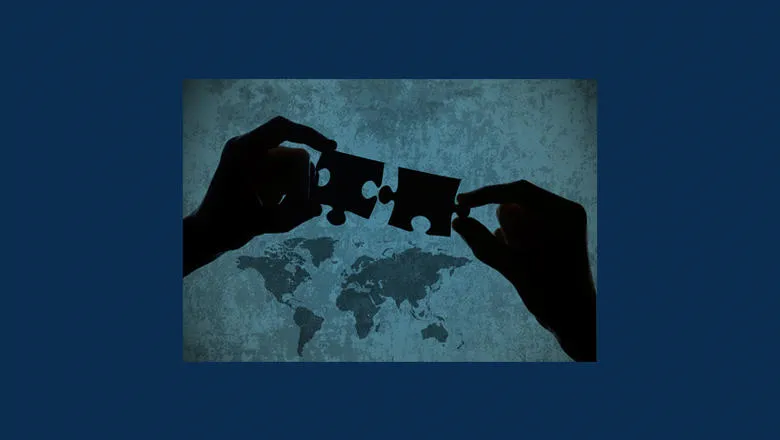22 March 2021
The Value of Having an Identity as a Multinational Firm
Dr Johann Fortwengel, Senior Lecturer in International Management
Doing not labelling is key to forming a multinational identity

Having a shared understanding of ‘who we are as an organization’ can be a critical influence on both day-to-day behaviour and strategic decision-making, guiding choices such as which markets to enter and what areas to invest in. But because identity can be so powerful it is important to get it right. For instance, an organization that defines itself as an analogue camera manufacturer, will have a hard time managing the transition to the digital age.[1] One solution is to develop an identity that is broad enough to encompass different employees, divisions, products, and technologies. For many businesses the right identity will be that of the multinational firm.
Whether you are a multinational that has grown that way over time, or whether you are one of the new breed of digital company that has had an international presence almost from the outset, acknowledging your identity as a multinational suggests certain behaviours; knowledge sharing, learning, and collaboration across locations in different countries. If you feel you are part of a big corporate family spread across the globe, you are more likely to reach out to your colleagues in China, Germany, or the US for advice on how to solve a local problem, and for their input on market trends and the future of your business. This sharing and combining of knowledge is critical to remain competitive.

Recent research[2] using archival and interview data spanning almost three decades has mapped how an automotive company formed an identity as a multinational enterprise. This identity developed slowly over time, as the company became increasingly international in its workforce, production, and sales. As a result of its emerging multinational identity, the company started to develop and share good practices across the intra-firm network, ranging from sustainability to communication and workforce training practices. In the process it sustained its competitiveness in the rapidly-changing industry.
Building a multinational identity
Research suggests that ‘identity management’ aiming to impose a multinational firm identity through signifiers like labelling is perhaps not the most effective approach. Rather, managers throughout the organization should create an environment in which such an identity can emerge slowly and organically. A set of concrete behaviours contribute to the formation of a multinational identity.
- Talk about the organization as a whole, and not about whether it’s a German, American, British, or Japanese firm. In conversations with internal and external stakeholders, many managers and employees tend to introduce their company by referring to the home country. Framing your company as American or Chinese, however, creates invisible barriers in the minds of your employees, making some colleagues feel excluded and collaboration and advice-seeking less likely.
- Embed a multinational and global outlook in your day-to-day activities. When you talk to your team or give internal speeches, highlight the multinational and global dimension of your business. Refer to examples from multiple locations and highlight the similarities in the challenges experienced by various domestic and foreign locations. This again creates a sense of a shared understanding and empathy.
- Run a program offering employees to spend a short time at another location. Many organizations have these kinds of programs, but visits are often linked to a specific objective, such as turning around an ailing business or helping to ramp up production. By encouraging visits without a specific mission, managers bring home the message that it’s about building ties and relationships across locations, which can then be leveraged in the future to work on the solution for a local or global problem.
- Create project teams with members from different locations, and organize yearly functional conferences at varying locations, not only at your headquarters. This creates a sense of ownership and pride on the part of the overseas locations, who will feel ‘seen’ and acknowledged in their role and capabilities. And headquarters personnel will further develop a sense of a global outlook. While physical conferences may not be possible in the current pandemic, multinational project teams can operate virtually.
- Recruit internationally for leadership positions. Give your company a visibly diverse face. This is a powerful signal internally that there is no glass ceiling for nationals from outside the home country of the company, and these leaders can be powerful champions of the global and multinational outlook you seek to nurture.
Over time, as a result of consciously fostering a multinational identity, employees will feel part of one organization, no matter where they are based. They will leverage the knowledge resources based at locations around the world that are often hidden in large and complex organizations. The multinational identity will help the organization to become a learning organization that is better equipped to solve problems, whether big or small, local or global; it will become central to its ability to sustain competitiveness in a constantly changing business environment.
[1] Tripsas, M. (2009): Technology, identity, and inertia through the lens of ‘The Digital Photography Company.’ Organization Science, 20(2): 441—460.
[2] Fortwengel, J. (2021): The formation of an MNE identity over the course of internationalization. Journal of International Business Studies: forthcoming.

